
Every year I have to reorganize my pantry at least twice – usually during the spring and fall. Our food choices change, our stockpiles change, we get new equipment, and everything has to change to accommodate it. So I’ve put together a list of organizing tips to help you with your challenges. Whether you’re an organizing pro or just getting started, I hope that one of these ideas helps you gain a little control over what can become preparedness clutter!
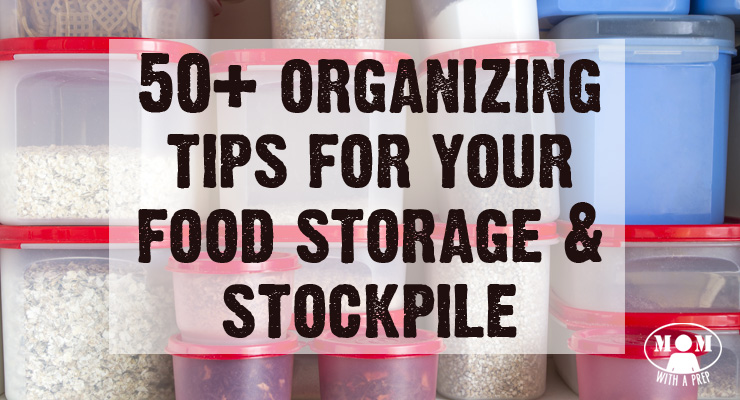
50+ Organizing Tips for Food Storage & Emergency Supplies
- A place like items on the same shelf. Store your most-used foods where they are easiest to access.
- Devise a system that works for you. I like to keep baking good together, fruit storage together (canned and dehydrated), soups together, grains together, etc. Some folks like to alphabetize because it’s how their brain works. Don’t be afraid to try a few different ways until it clicks for you.
- Mark Expiration Dates with a sharpie in a visible location.
- Rotate – first in first out is a good rule of thumb. It may be a pain after a shopping trip depending on what your shelves are like, but rotate through your food storage to ensure that you’re not stuck with old food. This even goes for that food you store but might not eat often. Get it out of the cupboard occasionally and use it or donate it and bring in a fresh supply.
Putting Lable to Organize
- Label everything! Have you ever picked up a mystery package from the freezer and can’t identify it? Think back to when you put it in the freezer and thought, “That won’t be hard to figure out later…” LABEL IT! (and let me tell you – you can get obsessed with labeling everything in your house with this guy! But I also just use a piece of masking tape and sharpie, too!)
- Oldest foods upfront to use first – this isn’t just about rotation, but about setting your pantry up in the first place. You should keep the oldest food to the front so that you can use it quickly.
- Use totes for organizing the same kinds of foods or packing in meal plans. Here are just a few organizing tips:
- Keep a tote for sewing supplies;
- Keep a tote for first aid supplies;
- Keep a tote for cleaning supplies, etc.;
- Emergency kits for each member of the family.
Tip – don’t use the plastic totes for actual food storage unless you are sure that it is completely airtight when closed and free from pest invasion.
More Organizing Tips for Food Storage & Emergency Supplies
- Use Food Grade 3 or 5-gallon buckets to store like items or “categories” or emergency kits. You can use the regular lids or invest in the Gamma Lids which help reduce oxygen and moisture from getting in. Here are just a few organizing tips:
- Store single grains;
- Store emergency kits;
- Store like categories;
- Create monthly meal plans.
- Repackage bulk foods in mylar or vacuum seal into bags or canning jars.
- Repackage boxed items in more appropriate long-term storage containers (vacuum-sealed canning jars, mylar bags, vacuum-sealed bags).
- Use 55-gallon drums to store items – just remember a hand truck may be necessary to move, so be careful what you expect to store. There are a lot of different kinds of drums that can be used for hard goods as well as water. Keep an eye out and you may be able to get them for free! Just be careful to know their history and what was originally stored in them. You’d be amazed at how many clothes or linens you can store in a big drum.
- Don’t store everything in one place. Store items throughout your house, in good storage areas where light and temperature fluctuations can’t hurt them.
Additional Tips in Storing Your Food Products
- Don’t store items that are sensitive to weather changes outdoors. Food products should be kept inside, but paper goods can be kept in outdoor storage as long as it is critter-proof.
- Keep a running list of your inventory always. Not only will it help you not overby in an area and potentially waste money and resources, but it will also allow you to see weak areas and plan accordingly.
- Label buckets, bags, and unidentifiable containers not only with names and expiration dates but cooking instructions, too. You can print out the instructions or write them on an index card and tuck that into your package or tape it to the outside. It’s handy to have it in your food storage binder, but even better to have it right on the package.
- Don’t overstuff totes or buckets with more than you can carry by hand or by the tool.
- Utilize unused space to store:
- Behind the sofa;
- Underside tables;
- Closet floors;
- Under beds.
- Increase shelf space by putting a shelf above closet doors or adding shelves to dead space.
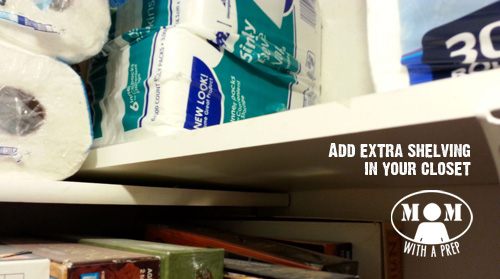
- Utilize attic space for non-food items as long as stored in pest-resistant containers.
- Utilize the backsides of doors with hanging racks to store more items.
- Use a tackle box for emergency medical supplies and store it under the sink.
- Use your stored coolers to store items when not in use
- Utilize a kid’s wagon to store and move storage throughout the house.
- Use odd space in your home to install shelves and have extra storage space.
Organizing Tips
- Line your open shelves. If you like using the pretty metal kitchen storage stations, use a thin sheet of styrofoam or plexiglass or other rigid material to line the shelves to keep things from falling in between the slats. There are some specially made liners, but you could also use some of the inexpensive cutting boards you can get at the dollar store to convert, too (I did that for my Nesco Dehydrator, too!)
- Try to use square storage canisters to not waste space – or at least try to organize with the same system to make storing on shelves easier.
- Create shelving units in unexpected places to add more storage. Think bin storage on your garage ceiling, removing the drywall and storing between studs, finding cubby holes in your house, and putting in shelves. (Check out my Pinterest board all about organization in the garage).
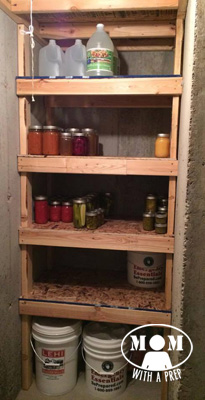
More Organizing Tips
- Use bins from other storage systems (think garage or automotive) – Look how we used this magazine holder in our pantry.
- Alphabetize things to make them easier to find.
- Keep a notebook full of information on:
- What you have stored?
- Where do you have it stored?
- Expiration dates or purchase dates especially for things like fuel, equipment, etc.
- Use a color-coding system for things like food, water, first aid, camping equipment, etc. If you’re doing something like bucket storage or tote storage, you can choose the Gamma lid or tote color for each segment of your storage.
- Use a bookshelf with a pretty fabric covering the front to store things in boxes and baskets.
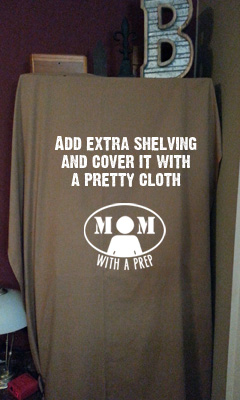
(I didn’t tuck in the sides as I’d just added stuff to it before taking this photo – and while the fabric isn’t pretty, it blends into our wall color naturally so it isn’t as noticeable when you walk into the room. Behind it, we keep all sorts of food storage and other sundries. On the side with the lamp, I have a hook and loop tab that connects the fabric edge to the bookshelf that keeps it tidy.)
- Use sturdy shelving units. Cheap ones will bow, warp or break.
- Don’t store more on shelving units than suggested;
- Don’t store heavy items on top of shelving units;
- Brace shelving units to the wall, if possible, to keep them from falling.
Alternative Uses for Food Storage as Furniture
- Create a ‘box spring’ of food storage containers for your mattress.
- Create a tower of food storage items and drape it with cloth, or place a square or round of MDF as a topper to create a side table.
Final Advice
There’s nothing better than organized food storage. It will be easy for you to find what you need when everything is in place. And it will be more convenient to have an arrangement that will be easy to track. At the same time, keeping things orderly will make so much difference. Thus, we hope that these tips will be of help to you.
Finally, here are some pages and videos from other preparedness-minded folk and their food storage areas. Hopefully, these organizing tips will help you.
- Take a tour of Megan’s food storage
- Take a tour of Healthy Prepper’s storage
- Bill’s Food Storage (with lots of other tips, too)
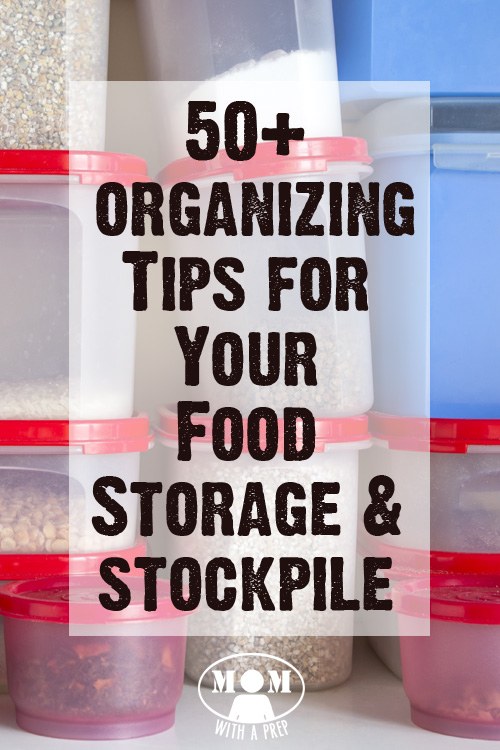
Katy Willis is a writer, lifelong homesteader, and master herbalist, master gardener, and canine nutritionist. Katy is a preparedness expert and modern homesteader practicing everyday preparedness, sustainability, and a holistic lifestyle.
She knows how important it is to be prepared for whatever life throws at you, because you just never know what's coming. And preparedness helps you give your family the best chance to thrive in any situation.
Katy is passionate about living naturally, growing food, keeping livestock, foraging, and making and using herbal remedies. Katy is an experienced herbalist and a member of the CMA (Complementary Medical Association).
Her preparedness skills go beyond just being "ready", she's ready to survive the initial disaster, and thrive afterward, too. She grows 100% organic food on roughly 15 acres and raises goats, chickens, and ducks. She also lovingly tends her orchard, where she grows many different fruit trees. And, because she likes to know exactly what she's feeding her family, she's a seasoned from-scratch cook and gluten-free baker.
Katy teaches foraging and environmental education classes, too, including self-sufficient living, modern homesteading, seed saving, and organic vegetable gardening.
Katy helps others learn forgotten skills, including basic survival skills and self-reliance.
She's been published on sites such as MSN, Angi, Home Advisor, Family Handyman, Wealth of Geeks, Readers Digest, and more.

I liked your idea to use a color-coding system to organize your storage unit. I’m trying to get a good idea of how to organize everything, since we just got a storage unit to keep everything in. We’ll be sure to see if we can make this work with what we have going on.